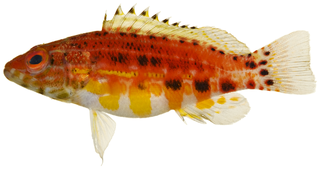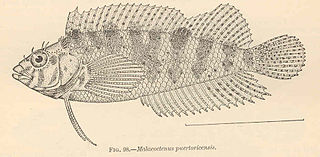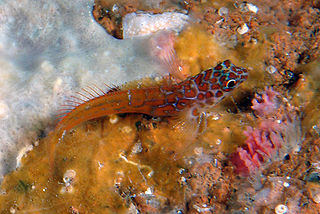
Combtooth blennies are blenniiformids; percomorph marine fish of the family Blenniidae, part of the order Blenniiformes. They are the largest family of blennies with around 401 known species in 58 genera. Combtooth blennies are found in tropical and subtropical waters in the Atlantic, Pacific and Indian Oceans; some species are also found in brackish and even freshwater environments.

Labrisomids are small blennioids (blennies), percomorph marine fish belonging to the family Labrisomidae. Found mostly in the tropical Atlantic and Pacific Ocean, the family contains about 110 species in 15 genera.

Serranus is a genus of fish in the family Serranidae. It is one of five genera known commonly as the "Atlantic dwarf sea basses". These fish are hermaphrodites, each individual possessing functional male and female reproductive tissues. When a pair spawns, one fish acts as a male and the other acts as a female.

Malacoctenus boehlkei, the Diamond blenny, is a species of labrisomid blenny native to the central western Atlantic Ocean and the Caribbean Sea where it is an inhabitant of coral reefs at depths of from 5 to 70 metres. This species can reach a length of 6.4 centimetres (2.5 in) TL. The specific name honour the ichthyologist James E. Böhlke (1930-1982), of the Academy of Natural Sciences of Philadelphia.

The molly miller is a species of marine ray-finned fish belonging to the family Blenniidae, the combtooth blennies. This species is found in the Atlantic, Mediterranean, and northwest Pacific Oceans. Its colour is a mottled tan, white, and black covering the body and fins. The head of this fish is covered with short hair-like appendages and has two very large eyes. This species reaches 12 cm (4.7 in) in total length.
Microlipophrys velifer, the sailfin blenny is a species of combtooth blenny found in the eastern Atlantic ocean off west Africa from Mauritania and Cape Verde to the Cunene River, Angola.

Parablennius is a diverse genus of combtooth blennies found in the Atlantic, western Pacific, and Indian Ocean.

The rock-pool blenny is a species of combtooth blenny found in the eastern central Atlantic Ocean. This species reaches a length of 12 centimetres (4.7 in) SL.
Chaenopsis coheni, the Cortez pikeblenny, is a species of chaenopsid blenny found around the Isla Angel de la Guarda, in the Gulf of California, in the eastern central Pacific ocean. It has not been recorded since 1965. The specific name honours Daniel M. Cohen (1930-2017) of Stanford University who accompanied Böhlke on the expedition that collected the type.
Chaenopsis schmitti, the yellow-mouth pikeblenny, is a species of chaenopsid blenny found in coral reefs in the eastern central Pacific ocean. It can reach a maximum length of 8 centimetres (3.1 in) TL. The specific name honours the carcinologist Waldo L. Schmitt (1887-1977) who was Curator of the Division of Marine Invertebrates in the US National Museum and who was responsible for the collection of the two types.
Emblemaria caycedoi, the Colombian blenny, is a species of chaenopsid blenny found around Venezuela and Isla de Providencia, Colombia, in the western central Atlantic Ocean. The specific name honours the young marine biologist Enrique Caycedo Lara, who died in 1978.

Paraclinus is a genus of labrisomid blennies native to eastern Pacific Ocean and the western Atlantic Ocean.

Starksia is a genus of labrisomid blennies native to the western Atlantic Ocean and the eastern Pacific Ocean. Their typical length is 2 cm (0.79 in) SL. The generic name honours the American ichthyologist Edwin Chapin Starks (1867-1932) of Stanford University for his work on Pacific coastal fishes. As a genus Starksia is distinguished from other labrisomids by their scaled bodies, two obvious soft rays in the pelvic fin and the male's have an intromittent organ which is near to or attached to the first spine of their anal fins, which is also somewhat separated from the fin.

Malacoctenus gilli, the dusky blenny, is a species of labrisomid blenny native to the Atlantic Ocean including the Gulf of Mexico and the Caribbean Sea from the Bahamas to the north coast of South America. This species inhabits reef patches, areas of sandy substrates with available rocks and beds of seagrass at depths of from 1 to 5 metres. It can reach a length of 7.6 centimetres (3.0 in) TL. The person honoured in the patronym of this species was not identified by Steindachner but it is most probably the American ichthyologist Theodore Nicholas Gill (1837-1914), the authority for the generic name Malacoctenus.
Malacoctenus delalandii is a species of labrisomid blenny native to the Atlantic Ocean and the Caribbean Sea from Guatemala to Brazil. This species is an inhabitant of coral reefs being found in sandy areas and around beds of the seagrass Thalassia testudinum. It can reach a length of 8.2 centimetres (3.2 in) TL. The specific name honours the French explorer and naturalist Pierre Antoine Delalande (1787-1823), who collected the type.

Malacoctenus ebisui, the Fishgod blenny, is a species of labrisomid blenny native to the Pacific coast of the Americas from the Gulf of California to Panama. This species can reach a length of 6.5 centimetres (2.6 in) TL. The specific name refers to Ebisu, a Japanese god of fishermen, as does the common name.
Malacoctenus erdmani is a species of labrisomid blenny native to the western Atlantic Ocean and the Caribbean Sea from the Bahamas to Curaçao. This species is an inhabitant of reefs where it prefers areas that provide hiding places such as coral rubble and rock and patches of algae. It can reach a length of 3.8 centimetres (1.5 in) TL. The specific name honours the fishery biologist Donald S. Erdman.
Malacoctenus hubbsi, the redside blenny, is a species of labrisomid blenny native to the Gulf of California extending to the Pacific coast of southern Baja California. It is found in rocky areas at depths of from 1 to 4 metres. This species can reach a length of 9 centimetres (3.5 in) TL. The specific name honours the American ichthyologist Clark Hubbs (1921-2008).

Microlipophrys is a genus of combtooth blennies found in Atlantic ocean and the Mediterranean Sea.
Gobioclinus is a genus of labrisomid blennies from the coasts of the western Atlantic and eastern Pacific Oceans off the Americas.











